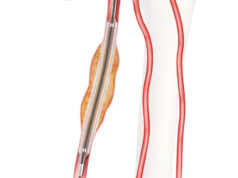 Principal investigator of the VOYAGER PAD trial, Marc Bonaca (University of Colorado Anschutz Medical Campus, Aurora, USA) speaks to Vascular News about the latest data from the study, which indicate that patients with claudication are at high risk for adverse limb events and cardiovascular events after undergoing revascularisation. Bonaca highlights the significance of the findings—which he presented the findings at the American Heart Association (AHA) Scientific Sessions (13–15 November, virtual)—and, speaking on what is next for VOAYGER PAD, relays that “there is a lot yet to come”.
Principal investigator of the VOYAGER PAD trial, Marc Bonaca (University of Colorado Anschutz Medical Campus, Aurora, USA) speaks to Vascular News about the latest data from the study, which indicate that patients with claudication are at high risk for adverse limb events and cardiovascular events after undergoing revascularisation. Bonaca highlights the significance of the findings—which he presented the findings at the American Heart Association (AHA) Scientific Sessions (13–15 November, virtual)—and, speaking on what is next for VOAYGER PAD, relays that “there is a lot yet to come”.
What are the key takeaway message from this new subanalysis?
We learned that patients who underwent revascularisation for claudication were severely disabled, with 62% unable to or able to with much difficulty for walking two blocks. We also found that revascularisation was effective in the short term in terms of haemodynamics (ankle-brachial index), patient-reported outcomes (the 62% with disability was reduced to 18%), and in terms of physician assessment (61% with moderate or severe symptoms were asymptomatic or with mild symptoms after the procedure). The benefit on patient-reported outcomes appeared durable out to about two years. With these benefits, however, we saw that the risk of major adverse limb events like amputation and acute limb ischaemia were frequent and increased fourfold on what we see for patients with claudication who have not progressed to needing revascularisation. Finally, we saw a significant benefit of rivaroxaban with regard to irreversible harm events of the heart, limb and brain, with a number needed to treat less than 50, and while there was more bleeding with rivaroxaban, there was a net benefit in this population when looking at events prevented/caused or the net outcome of event-free survival.
Why was it important to carry out a subanalysis of patients with chronic peripheral arterial disease (PAD) who have claudication?
Many clinicians may consider patients with claudication at lower risk of adverse limb events and therefore question the risk/benefit of intensive antithrombotic therapy. It was important to understand the risks in the population and the risk/benefit of therapy.
Are there any findings of the that surprised you?
The data on the durability of benefit for symptoms was surprising and encouraging. The data showing the very high risk of adverse limb events was concerning and surprising.
VOYAGER PAD updates always interest our readers—why do think that might be?
VOYAGER PAD was a unique trial. There are very few trials in PAD and this is the largest post revascularisation trial. Beyond the efficacy and safety of rivaroxaban, it serves as an important dataset to learn about PAD as a disease state and how we can better risk stratify and treat this extremely high-risk population.
What is next for VOYAGER PAD?
There is a lot yet to come and in some ways we have just started. We have extensive data on patient-reported outcomes to understand disability in this population. We have analyses understanding how optimal medical therapy (e.g. statin use) impacts the risk benefit of rivaroxaban and overall risk. We have subgroup analyses exploring high risk subgroups like those with chronic kidney disease. We also have limb specific analyses such as validation of the Wound, Ischemia and food Infection (WIfI) classification, and data to come from an angiographic core lab of over 2000 images. Like all trials, VOYAGER PAD was a collaborative effort and many are participating and leading these important analyses.










